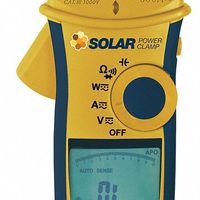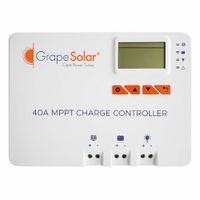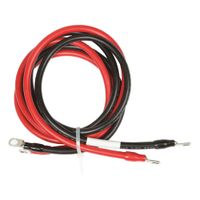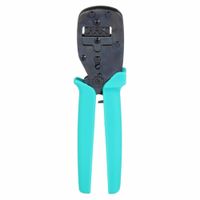Call +(254) 703 030 000 / 751 483 999 / 721 704 777
- Home
- Electrical
- Solar Panels Accessories
.....Read More
Frequently Asked Questions
What are solar panels and how do they work?
Solar panels, also known as photovoltaic (PV) panels, convert sunlight into electricity. They are made up of many small solar cells, usually composed of silicon, which is a semiconductor material.
When sunlight hits a solar cell, the photons in the light energy excite electrons in the silicon. This causes the electrons to break free from their atoms and start flowing, creating an electric current. This is known as the photovoltaic effect.
Each solar cell generates a small amount of direct current (DC) electricity. These individual cells are connected together to form a solar panel, which then produces a greater amount of electricity. Multiple solar panels can be connected in an array to generate even more power.
The DC electricity produced by solar panels is then sent to an inverter, a crucial component that converts the DC electricity into alternating current (AC) electricity. AC electricity is the type of power used by most homes and businesses and is compatible with the electrical grid.
From the inverter, the AC electricity can be used to power appliances in a building, stored in batteries for later use, or fed back into the electrical grid. When electricity is fed back into the grid, it can offset the amount of electricity purchased from the utility company, potentially leading to lower energy bills. Solar panels offer a clean, renewable energy source that reduces reliance on fossil fuels and helps mitigate climate change.
How much do solar panels cost?
The cost of solar panels can vary significantly based on several factors, including the size of the system, the type of panels, installation costs, and any available government incentives or tax credits. On average, a typical residential solar panel system in the U.S. can range from $15,000 to $25,000 before incentives. This cost includes the panels themselves, inverters, mounting hardware, wiring, and labor for installation.
Factors influencing the price include: * System Size: Larger homes or those with higher energy consumption will require a larger system, leading to higher costs.
* Panel Efficiency and Brand: More efficient panels or premium brands tend to be more expensive.
* Installation Complexity: Roof type, angle, and accessibility can impact labor costs.
* Local Incentives: Federal, state, and local incentives, such as the federal solar tax credit (currently 30%), can significantly reduce the net cost.
* Financing Options: Cash purchases, solar loans, or leases will have different long-term financial implications.It's always recommended to get multiple quotes from different solar installers to compare prices and options tailored to your specific energy needs and location.
How long do solar panels last?
Solar panels are designed to be durable and long-lasting, typically having a lifespan of 25 to 30 years or even more. This longevity is supported by manufacturer warranties, which usually guarantee a certain percentage of the original power output for two to three decades. For example, a common warranty might promise 80% power output after 25 years.
Several factors contribute to their lifespan, including the quality of the materials, the manufacturing process, and environmental conditions. High-quality panels from reputable brands tend to degrade more slowly. Environmental factors like extreme temperatures, humidity, and hail can impact performance over time, though panels are built to withstand harsh weather. Regular cleaning and maintenance, such as removing dust and debris, can help maintain their efficiency and extend their operational life. While the panels themselves can last for decades, other components of a solar energy system, like inverters, might have shorter lifespans and may need to be replaced sooner. Despite eventual degradation, solar panels continue to produce electricity beyond their warranty period, albeit at a reduced efficiency.
What is the difference between monocrystalline and polycrystalline solar panels?
Monocrystalline and polycrystalline solar panels are the two most common types of photovoltaic (PV) panels, differing primarily in their manufacturing process, appearance, and efficiency.
Monocrystalline panels are made from a single, pure crystal of silicon, which is grown into a large cylindrical ingot and then sliced into thin wafers. This uniform structure gives them a darker, often black, appearance. Because the silicon is a single crystal, electrons have more room to move, resulting in higher efficiency ratings, typically ranging from 17% to 22%. They also tend to perform better in low-light conditions and require less space for installation due to their higher power output per square foot. However, the manufacturing process for monocrystalline panels is more complex and energy-intensive, making them generally more expensive.
Polycrystalline panels, on the other hand, are made from multiple silicon crystals melted together and poured into a mold before being cut into wafers. This process results in a fragmented, bluish, or speckled appearance as the light reflects off the various silicon grains. The presence of multiple crystals creates more boundaries for electrons to move through, leading to slightly lower efficiency, typically between 15% and 17%. While they may not perform as well in low-light conditions as monocrystalline panels, their simpler manufacturing process makes them more affordable to produce and purchase. They are often a more cost-effective choice for larger installations where space is not a primary constraint.
How do solar inverters work?
Solar inverters are crucial components of a solar power system, acting as the "brain" that converts the direct current (DC) electricity generated by solar panels into alternating current (AC) electricity, which is the type of electricity used in homes and businesses and fed into the electrical grid.
Here's how they work:1. **DC Power from Panels:** Solar panels produce DC power when sunlight hits their photovoltaic cells. This DC power has a constant voltage and current in one direction.
2. **Conversion to AC:** The solar inverter takes this DC power as input. Inside the inverter, electronic components, primarily transistors, rapidly switch the direction of the DC current. This rapid switching creates a waveform that mimics AC electricity.
3. **Synchronization with Grid:** The inverter also synchronizes the AC power it produces with the frequency and voltage of the electrical grid. This is vital for safety and efficiency, ensuring that the solar power can be seamlessly integrated into the existing electrical infrastructure.
4. **Monitoring and Optimization:** Modern inverters often include advanced features for monitoring the performance of the solar array, detecting faults, and optimizing power production. Some inverters can even communicate with smart home systems or provide real-time data through mobile apps.There are different types of inverters, including string inverters, microinverters, and power optimizers, each with its own advantages depending on the specific solar installation.
What is a solar charge controller and why is it important?
A solar charge controller is a vital component in a solar power system, acting as an intermediary between the solar panels and the battery bank. Its primary function is to regulate the voltage and current coming from the solar panels to prevent overcharging or deep discharging of the batteries, which can significantly reduce their lifespan and performance.
There are two main types: Pulse Width Modulation (PWM) and Maximum Power Point Tracking (MPPT). PWM controllers are simpler and more affordable, best suited for small systems where the panel voltage matches the battery voltage. MPPT controllers are more advanced, capable of optimizing the power output from the solar panels to maximize charging efficiency, especially in larger or more complex systems.
The importance of a solar charge controller lies in its ability to protect the battery bank, which is often the most expensive component in a solar setup. Without proper regulation, batteries can be damaged by excessive voltage or current, leading to premature failure. It also ensures efficient charging, allowing the solar system to extract the maximum available power from the sun and deliver it to the batteries, ultimately improving the overall reliability and longevity of the solar power system.
How do I maintain and clean solar panels?
Maintaining and cleaning solar panels is crucial for optimizing their efficiency and lifespan. Regular maintenance typically involves visual inspections to check for any physical damage, debris buildup, or shading issues. It's recommended to perform these checks every few months.
For cleaning, rainfall often does a decent job of washing away light dust and pollen. However, for more stubborn dirt, bird droppings, or accumulated grime, manual cleaning is necessary. The best time to clean panels is usually in the early morning or late evening when they are cool, to prevent water from evaporating too quickly and leaving streaks.
Use a soft brush or a squeegee with a long handle, along with plain water or a mild, non-abrasive cleaning solution specifically designed for solar panels. Avoid using harsh chemicals, abrasive materials, or high-pressure washers, as these can damage the panel surface or coatings. For safety, always turn off the power to the panels before cleaning and consider hiring a professional if the panels are on a high or difficult-to-access roof. Proper cleaning can ensure your solar panels continue to perform at their best, maximizing your energy savings.
Can solar panels work during cloudy or rainy days?
Yes, solar panels can work during cloudy or rainy days, though their efficiency is reduced. Modern solar panels are designed to capture both direct and diffused sunlight. On cloudy days, diffused sunlight still reaches the panels, allowing them to generate electricity, albeit at a lower rate (typically 10-25% of their full capacity). During rainy days, the effect is similar; while direct sunlight is blocked, the rain itself can even help by washing dust and debris off the panels, improving their long-term performance. Advanced solar panel technology, such as those with improved low-light performance and microinverters, also helps maximize energy production even in less-than-ideal weather conditions.
How do I choose the right solar panel system for my home?
Choosing the right solar panel system for your home involves several key considerations to ensure it meets your energy needs and budget.
First, assess your energy consumption. Review your past electricity bills to understand your average monthly kilowatt-hour (kWh) usage. This will help determine the system size needed to offset your energy consumption.
Next, evaluate your roof. Consider its size, angle, and sun exposure throughout the day. South-facing roofs typically receive the most sunlight, maximizing energy production. Shading from trees or other buildings can significantly impact efficiency.
Research different types of solar panels. Monocrystalline panels are known for high efficiency and sleek appearance but are generally more expensive. Polycrystalline panels are more affordable but slightly less efficient. Thin-film panels are flexible but less common for residential use.
Consider your budget and financial incentives. Solar panel systems can be a significant investment, but various federal, state, and local incentives, such as tax credits, rebates, and net metering programs, can significantly reduce the cost.
Finally, choose a reputable solar installer. Look for companies with strong track records, positive customer reviews, and relevant certifications. A good installer will conduct a thorough site assessment, design a system tailored to your needs, and handle the installation and permitting process.
What are the benefits of using solar energy?
Using solar energy offers numerous benefits for individuals and the environment. Environmentally, it significantly reduces carbon footprints by generating clean electricity without emitting greenhouse gases, thus combating climate change and air pollution. Economically, solar panels lead to substantial savings on electricity bills, as you generate your own power, and can even earn money through net metering by selling excess electricity back to the grid. The cost of solar technology has also decreased over the years, making it a more accessible and affordable option for many. Furthermore, solar energy systems are low-maintenance and durable, providing a reliable power source for decades. They also increase energy independence by reducing reliance on finite fossil fuels and centralized power grids, enhancing energy security, especially in remote areas or during outages. Investing in solar energy can also boost property values, making homes more attractive to environmentally conscious buyers.





